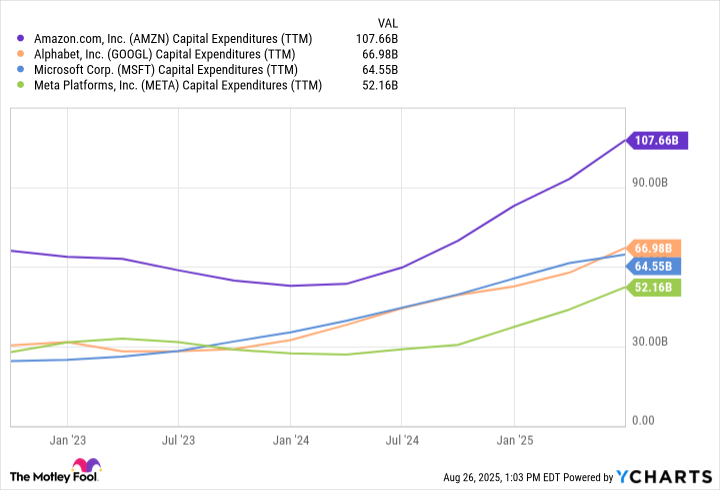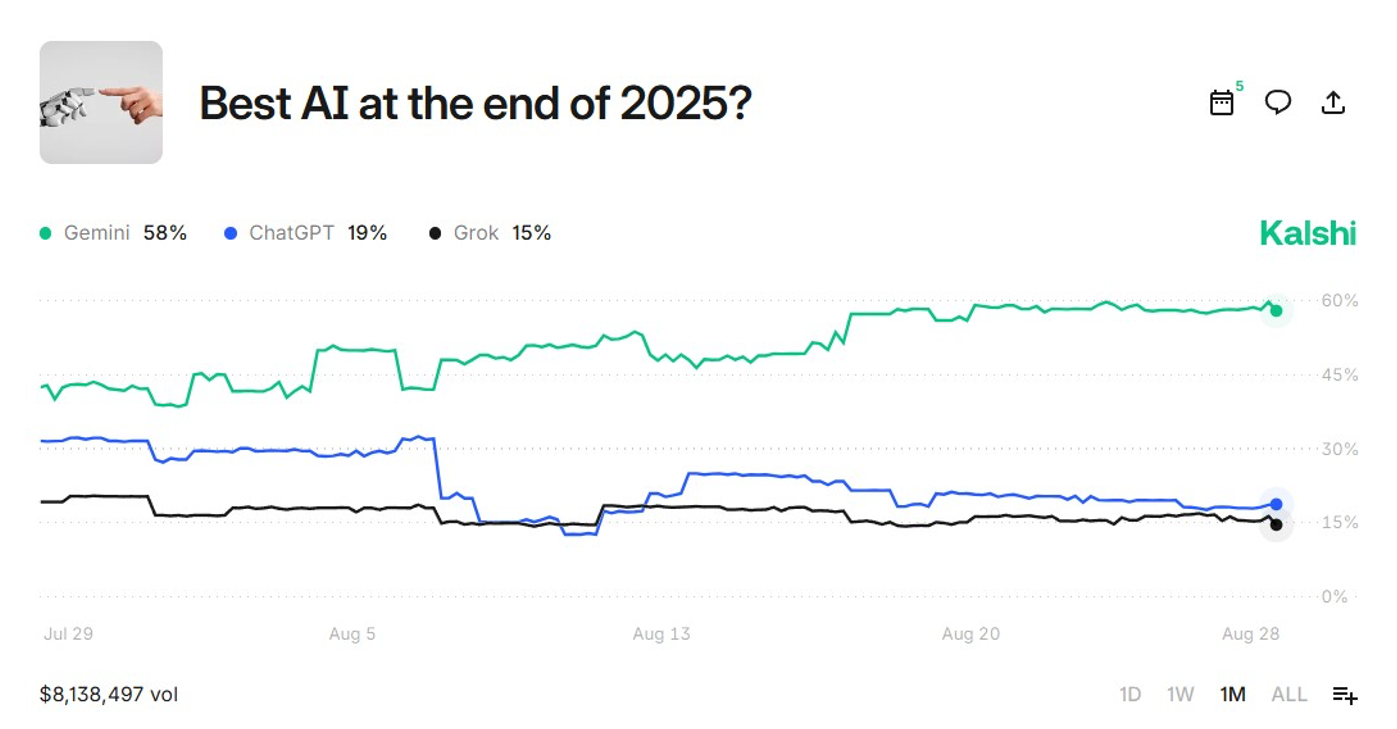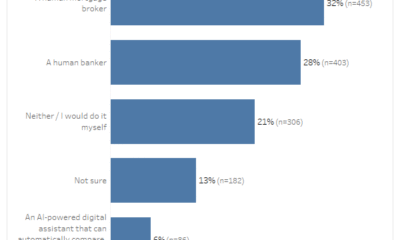Cloudflare Debuts Bot Blocker to Help ‘Internet Survive Age of AI’

Software firm Cloudflare has introduced a tool to block bot crawlers from accessing web content without permission.

AI Insights
Prediction: This Monster Artificial Intelligence (AI) Chip Stock Will Soar in September (Hint: It’s Not Nvidia)

Broadcom is scheduled to report earnings on Sept. 4.
Over the past several weeks, investors have been bombarded with a wave of updates as companies reported earnings results for the second calendar quarter. For technology investors, artificial intelligence (AI) remains the dominant theme fueling the sector higher.
As I write this (mid-day on Aug. 27), all of the “Magnificent Seven” have posted earnings — with the lone exception being Nvidia (NVDA -3.38%), which reports later today. Still, the breadcrumbs left by big tech point to an undeniable trend: Spending on AI infrastructure is accelerating.
While this is undeniably bullish for graphics processing unit (GPU) leaders like Nvidia and Advanced Micro Devices, it also creates a powerful tailwind for systems integration specialist Broadcom (AVGO -3.70%).
With Broadcom slated to report earnings on Sept. 4, I predict the stock is well-positioned to rally.
Let’s explore why I’m optimistic about Broadcom’s upcoming earnings report, and assess whether the stock is a compelling buy at current levels.
Follow big tech’s breadcrumbs
Global hyperscalers such as Amazon, Alphabet, Microsoft, and Meta Platforms have been spending record sums on capital expenditures (capex) over the last few years. While this clearly bodes well for Nvidia and AMD, Broadcom has also been a quiet beneficiary of rising AI infrastructure investment.
Data by YCharts.
One of Broadcom’s key AI growth drivers comes from its application-specific integrated circuits (ASICs) business. These custom silicon solutions allow customers to design chips that are optimized for their unique workloads.
By integrating purpose-built performance with compute power efficiency, Broadcom’s ASICs help hyperscalers lower their total cost of infrastructure relative to relying solely on off-the-shelf accelerators from the likes of Nvidia. This becomes highly desirable as training and inferencing workloads scale and become increasingly complex as more sophisticated AI use cases unfold.
Broadcom’s networking division is also positioned to benefit materially from the ongoing AI infrastructure cycle. As big tech continues to pour hundreds of billions of dollars annually into GPU deployment, Broadcom’s supporting infrastructure becomes an indispensable unsung hero.
The company’s portfolio of high-performance switches, interconnects, and optical components delivers low-latency, high-bandwidth connectivity to keep next-generation accelerators running at full speed. In essence, the company’s networking gear represents a foundational layer of AI data center construction — ensuring scalability and efficiency as workloads expand.
Image source: Getty Images.
Management likes the stock — shouldn’t you?
With a forward price-to-earnings (P/E) multiple of 45, Broadcom certainly isn’t trading at a discount. In fact, its multiple sits near peak levels seen during the AI revolution.
Data by YCharts.
Even so, the company’s board of directors authorized a $10 billion stock buyback program back in April. Share buybacks at elevated valuations can point to a strong signal: Management remains confident in Broadcom’s long-term growth trajectory, underscored by ongoing hyperscaler investment. On a more subtle note, sometimes companies repurchase their own shares when management thinks the stock is undervalued.
These dynamics could suggest that Broadcom is positioned for sustained, robust earnings growth, which could fuel further valuation expansion — even in the face of a premium multiple.
Is Broadcom stock a buy right now?
For the last few years, the AI trade has largely surrounded Nvidia and the cloud hyperscalers. Yet as infrastructure spending accelerates, the scope of the AI opportunity is broadening to other mission-critical enablers such as Broadcom. Custom chips, high-performance networking equipment, and integrated systems are now just as essential as securing GPUs — and Broadcom sits squarely at this intersection.
In my eyes, Broadcom is approaching its own “Nvidia moment” — a potential inflection where the narrative begins to recognize Broadcom as a supporting pillar of AI infrastructure and not simply an ancillary beneficiary of these tailwinds.
Against this backdrop, I predict that Broadcom’s September earnings report will reinforce its strategic importance in the AI landscape — fueling investor enthusiasm and a further rerating of the stock. For these reasons, I see Broadcom as a compelling opportunity to buy and hold over a long-term time horizon.
Adam Spatacco has positions in Alphabet, Amazon, Meta Platforms, Microsoft, and Nvidia. The Motley Fool has positions in and recommends Advanced Micro Devices, Alphabet, Amazon, Meta Platforms, Microsoft, and Nvidia. The Motley Fool recommends Broadcom and recommends the following options: long January 2026 $395 calls on Microsoft and short January 2026 $405 calls on Microsoft. The Motley Fool has a disclosure policy.
AI Research
Intelligence is not artificial | The Catholic Register
On our Comment pages, Sr. Helena Burns issues a robust call for a return to “old school” means of acquiring, developing and retaining knowledge in the age of AI.
Traditionalist though she might be in many ways, however, Sr. Burns’ appeal is not simply to revive the alliterative formula of Readin’, Writin’ and Arithmetic. Rather, she urges a return to the lost arts of using libraries, taking notes, listening to wiser heads, and above all using our own brains rather than relying on the post in the machine to explain the world.
“We can rebuild a talking, thinking, literate, memorizing culture. But it’s a slow build. It always was, always will be, and it starts when you’re a kiddo. Children in school are now saying they don’t want to learn how to read and write because computers will do it for them. They don’t know that they’re surrendering their humanity,” she writes.
Advertisement
The good news is that the much-rumoured surrender seems to be much further off than predicted in the recent frenzy over ChatGPT and its cohorts purportedly being thisclose to taking over the world and doing everything from producing perfect sour grapes to writing editorials.
In facts, recent reports particularly in the financial press, suggest AI-mania is already plateauing, if not hitting a downward curve. That doesn’t mean it won’t still cause significant disruption in workplaces or in how we navigate the storm-tossed seas of daily life. It doesn’t mean we can simply shrug off the statistic Sr. Burns cites of a reported 47 per cent decline in neural engagement among those who relied on artificial intelligence to help complete an essay versus those who got ink under their fingernails.
But as techno journalist Asa Fitch reported last week, Meta Platforms has delayed rollout of its next AI iteration, Llama 4 Behemoth, because of engineering failures to significantly improve the previous model. Open AI, meanwhile, overhyped its follow up ChatGPT 5 and saw it effectively flatline in the market.
Business leaders, already sceptical of security and privacy concerns with AI, have hardly been reassured by the “tendency of even the best AI models to occasionally hallucinate wrong answers,” Fitch writes.
More critically, many businesses looking at the allure of AI don’t yet know, in very practical terms, what it can do for their particular sector. We tend to forget that from the “future is now” advent of the Internet, it took the better part of a decade before society began to appreciate its ubiquitous uses.
Advertisement
University of California, San Diego psychology professor Cory Miller points out there even more formidable barriers to broad AI adaptation. Not the least of such obstacles are the requirements for, as Miller says, “enormous hardware, constant access to vast training data, and unsustainable amounts of electrical power (emphasis added).”
How unsustainable? A human brain, Miller writes, “runs on 20 watts of power – less than a lightbulb.”
AI by contrast?
“To match the computational power of a single human brain, a leading AI system would require the same amount of energy that powers the entire city of Dallas. Let that sink in for a second. One lightbulb versus a city of 1.3 million people,” he says.
The comparison is arithmetically sobering. It’s also ultimately a hallelujah chorus to the glory of creation that is humankind. We exist in a culture awash – it often seems perversely pridefully – in self-underestimation and outright denigration. Oh, to deploy Hamlet’s immortal phrase, what a piece of work is man.
Without question, evil lurks in our darker corners and threatens to beset our best and brightest achievements. But achieve we do as we collectively engage the unique phenomenal 20-watt light bulb brains that are the universal gift from God, our Sovereign Lord and Creator.
In another column in our Comment section, Mary Marrocco illuminates the dynamic of that gift and that engagement, quoting St. Athanasius’ observation that “when we forgot to look up to God, God came down to the low place we’d fixed our gaze on.”
Advertisement
The outcome was the glorious rise of our Holy Mother the Church, whose cycle of liturgical years, year after year, reminds us of who we are, what we are, and to whom we truly belong.
There is not a shred of artificiality in the intelligence of the resulting library (biblio) of the Bible’s books, its Gospels, its Good News. There is only God’s Word, the most extraordinary conversation any child, any human being, could ever be invited to learn from
A version of this story appeared in the August 31, 2025, issue of The Catholic Register with the headline “Intelligence is not artificial“.
AI Insights
AI Model Betting Is the New Fantasy Football

Sports gambling has DraftKings. Political junkies have PredictIt. And now the world’s nerdiest corner — the artificial intelligence (AI) scene — has its own set of bettors, where people wager actual money on whether Google’s Gemini will dunk on OpenAI’s GPT-5 this month.
-
Tools & Platforms3 weeks ago
Building Trust in Military AI Starts with Opening the Black Box – War on the Rocks
-

 Ethics & Policy1 month ago
Ethics & Policy1 month agoSDAIA Supports Saudi Arabia’s Leadership in Shaping Global AI Ethics, Policy, and Research – وكالة الأنباء السعودية
-

 Events & Conferences3 months ago
Events & Conferences3 months agoJourney to 1000 models: Scaling Instagram’s recommendation system
-

 Jobs & Careers2 months ago
Jobs & Careers2 months agoMumbai-based Perplexity Alternative Has 60k+ Users Without Funding
-

 Funding & Business2 months ago
Funding & Business2 months agoKayak and Expedia race to build AI travel agents that turn social posts into itineraries
-

 Education2 months ago
Education2 months agoVEX Robotics launches AI-powered classroom robotics system
-

 Podcasts & Talks2 months ago
Podcasts & Talks2 months agoHappy 4th of July! 🎆 Made with Veo 3 in Gemini
-

 Podcasts & Talks2 months ago
Podcasts & Talks2 months agoOpenAI 🤝 @teamganassi
-

 Mergers & Acquisitions2 months ago
Mergers & Acquisitions2 months agoDonald Trump suggests US government review subsidies to Elon Musk’s companies
-

 Jobs & Careers2 months ago
Jobs & Careers2 months agoAstrophel Aerospace Raises ₹6.84 Crore to Build Reusable Launch Vehicle





















